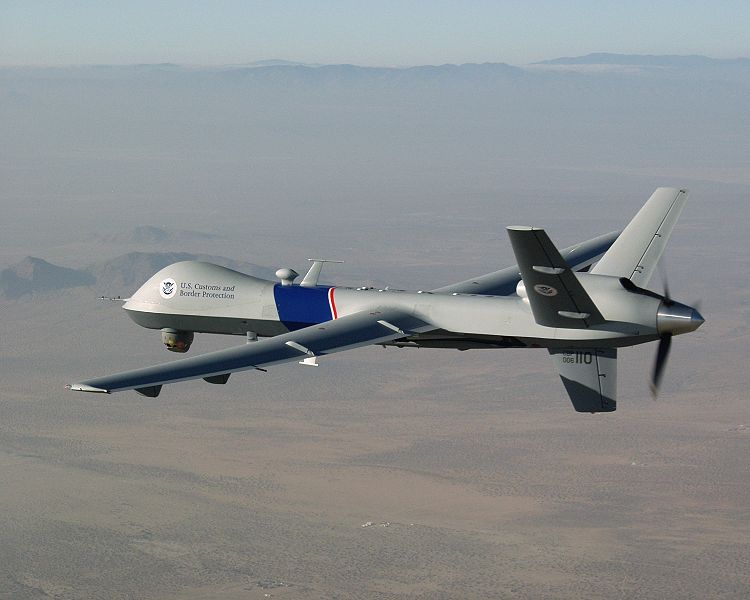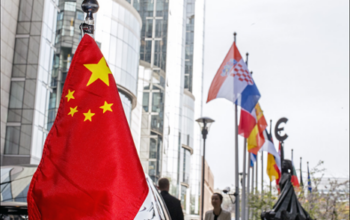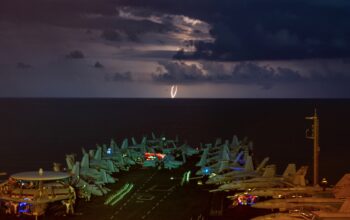Unmanned aerial vehicles (UAVs), colloquially known as drones, have existed since the mid-20th century but have really entered the public spotlight with the September 11th terrorist attacks and the start of the War on Terror. Coming in different shapes and sizes, modern military UAVs are the result of decades of technical and doctrinal development that promised to change the nature of how states conduct war and foreign policy. While many promises made by proponents of drone warfare have indeed come to fruition, drones still have many drawbacks both as military and political instruments. So just how has the rise of unmanned aerial vehicles changed world politics?
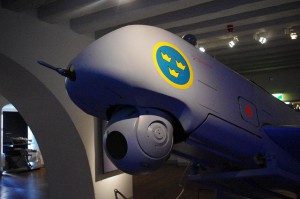 The basic definition of an unmanned aerial vehicle is any aircraft that can take off, fly and land without a person on board. This definition is very broad, but necessarily so, since military drones can range from a 400-gram Wasp surveillance drone to an enormous RQ-4 Global Hawk that weighs 15 tons and has the wingspan of a Boeing 757, with the most well known ones – the MQ-1 Predator and the MQ-9 Reaper – falling somewhere in the middle. Most military UAVs are made by American companies and used by American militaries or their allies. However, in recent years, many nations have begun either developing their own combat drones or purchasing them from other nations. Most drone exports come from the United States, but Israel and China also hold considerable share of the market. Chinese drones specifically have become very popular thanks to their low price and loose export regulations.
The basic definition of an unmanned aerial vehicle is any aircraft that can take off, fly and land without a person on board. This definition is very broad, but necessarily so, since military drones can range from a 400-gram Wasp surveillance drone to an enormous RQ-4 Global Hawk that weighs 15 tons and has the wingspan of a Boeing 757, with the most well known ones – the MQ-1 Predator and the MQ-9 Reaper – falling somewhere in the middle. Most military UAVs are made by American companies and used by American militaries or their allies. However, in recent years, many nations have begun either developing their own combat drones or purchasing them from other nations. Most drone exports come from the United States, but Israel and China also hold considerable share of the market. Chinese drones specifically have become very popular thanks to their low price and loose export regulations.
The experiences of both the first Gulf War and the interventions in former Yugoslavia and Africa revealed the possibilities offered by air power, smart munitions and superior reconnaissance in modern warfare. However, these same experiences also exposed the difficulty of sustaining public support for military operations abroad in the post-Cold War world. UAVs were the synthesis of those two experiences. They could provide intelligence and remote strike abilities without the possibility of politically problematic combat deaths. These capabilities became especially important given the increase in intrastate and asymmetrical conflicts in the 90’s and the 2000’s.
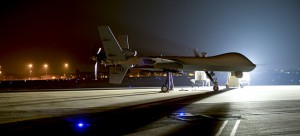 The biggest advantage of using UAVs for intelligence gathering and military attacks is obvious – there are no live humans exposed to battlefield dangers. Operations carried out using manned aircraft or on-the-ground agents can result in soldiers dying or being captured by the enemy. That can be difficult to explain to the voters at home. Even worse, it can result in a serious diplomatic incident if the mission is being carried out on the territory of a neutral or ostensibly friendly nation. For these reasons, drones have been the weapon of choice for the United States in places like Afghanistan, Pakistan, Syria and Yemen. And because drones are remotely operated, they can remain in position for 12 or more hours – much longer than manned aircraft – since their pilots can easily hand over the controls to a colleague.
The biggest advantage of using UAVs for intelligence gathering and military attacks is obvious – there are no live humans exposed to battlefield dangers. Operations carried out using manned aircraft or on-the-ground agents can result in soldiers dying or being captured by the enemy. That can be difficult to explain to the voters at home. Even worse, it can result in a serious diplomatic incident if the mission is being carried out on the territory of a neutral or ostensibly friendly nation. For these reasons, drones have been the weapon of choice for the United States in places like Afghanistan, Pakistan, Syria and Yemen. And because drones are remotely operated, they can remain in position for 12 or more hours – much longer than manned aircraft – since their pilots can easily hand over the controls to a colleague.
But if UAVs are so effective and do not place the lives of pilots and operatives at risk, it begs the question as to why have regular manned aerial strike or intelligence capabilities at all. It turns out that, for all of their upsides, drones have major technical and political downsides. For one, they tend to fall out of the sky for little reason. The United States Air Force has reported significant reliability issues with their fleet of drones and, in 2013, a US Army report stated that its drones crashed at nearly ten times the rate of manned aircraft. And while much of it can be attributed to mechanical issues, especially issues with the connection between a drone and its controller, many other accidents are the result of human error. Drone Wars UK’s Drone Crash Database is dominated with entries labelled “Pilot Error” where the drone’s controller accidentally steered it into mountains, shipping containers and once even a C-130 cargo plane. This is not surprising considering that UAV pilots spend over three times longer “in the air” than their manned aircraft counterparts. And in the American drone pilot corps at least, this problem is getting worse with 240 pilots leaving the job and only 180 new replacements arriving in 2014. Among reasons for leaving, the retiring operators cite long hours, fatigue and the general high-stress work atmosphere.
These are, however, hardly the only problems with military use of UAVs. For over a decade now, human rights groups have criticised drone strikes for causing unnecessary civilian casualties. This has been doubly problematic when UAVs have been used in ‘gray area’ conflicts like those in Pakistan or Yemen since these attacks are outside of normal wartime regulations. Finally, drones have proven, due to their low speed, very vulnerable when their targets are equipped with anti-air weaponry. This has recently been demonstrated by the loss of an American Predator drone to Syrian air defences and the shooting down of a UAE drone over Yemen during the conflict there. This limits drones’ effectiveness to areas where friendly forces can guarantee them safe skies.
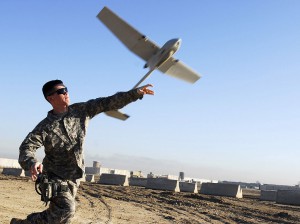 Even in those nations that provide freedom of movement for other nations’ UAVs or host drone operators, the support for drone warfare is rarely unanimous. Opposition groups and civil rights organizations in places that host American drones or their pilots, like Germany and Italy, regularly decry their nations’ complicity in what they criticise as illegal attacks. And in nations where drone strikes are being carried out, like Pakistan or Yemen, popular anger against the strikes has been directed against their leaders. Pakistan’s government continues to suffer from instability, especially in the country’s north-west, while Yemen’s government was overthrown, plunging the country into civil war.
Even in those nations that provide freedom of movement for other nations’ UAVs or host drone operators, the support for drone warfare is rarely unanimous. Opposition groups and civil rights organizations in places that host American drones or their pilots, like Germany and Italy, regularly decry their nations’ complicity in what they criticise as illegal attacks. And in nations where drone strikes are being carried out, like Pakistan or Yemen, popular anger against the strikes has been directed against their leaders. Pakistan’s government continues to suffer from instability, especially in the country’s north-west, while Yemen’s government was overthrown, plunging the country into civil war.
So what are the foreign policy implications of drone warfare? In a realist sense, they reinforce the advantage wealthier and more developed nations hold over smaller and less developed nations, since UAVs allow the former to carry out surveillance and military intervention against the latter at little cost. However, because combat drones are very vulnerable and rely on their targets’ lack of ability or political will to deploy air defences against them, this limits their effectiveness in interstate warfare. Since all but the weakest of states possess some form of air defence, the only enemies against which drones are effective are non-state actors without air defence capabilities. Likewise, the need for friendly skies and bases in the region of operations require a significant level of interstate cooperation to make drone use possible anywhere significantly beyond national borders. This gives less-powerful states in strategically-important positions, like Turkey or Pakistan, increased leverage over their great power allies, since without their consent, whether implicit or explicit, UAV operations through out their territory would be impossible.
The increased sophistication and frequency of use of UAVs was supposed to change how states conducted their foreign and security policies, but after a decade of experience, the changes wrought by drone warfare seem far more evolutionary than revolutionary. Rather than reducing the manpower requirements of modern militaries, drone operations have increased them and, rather than reduce the impact of public opinion on military operations, drone strikes have caused considerable opposition both at home and abroad. For realists, UAVs do little to alter the existing balance of power, while proponents of a more cooperative foreign policy use the requirements of drone warfare as yet another point in favour of the policies they already espoused. In short, drones have become just another tool in the security policy toolbox rather than the paradigm-changing super-weapons they were hyped up to be.
By Yaroslav Mikhaylov
Image Credit:
Cover: Gerald L. Nino, United States Customs and Border Protection, in public domain.
Image 1: Staffan Vilcans, licensed under CC BY-SA 2.0
Image 2: Staff Sgt. John Bainter, United States Air Force, in public domain.
Image 3: Sgt. David Hodge, U.S. Army, in public domain.
